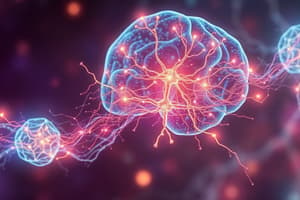Podcast
Questions and Answers
Methacholine is primarily used for the treatment of urinary bladder disorders
Methacholine is primarily used for the treatment of urinary bladder disorders
False (B)
Methacholine is given by inhalation for the diagnosis of bronchial hyper-reactivity
Methacholine is given by inhalation for the diagnosis of bronchial hyper-reactivity
True (A)
Muscarinic receptor agonists can be classified into two classes: synthetic choline esters and cholinomimetic alkaloids
Muscarinic receptor agonists can be classified into two classes: synthetic choline esters and cholinomimetic alkaloids
True (A)
Bethanechol is contraindicated for the treatment of urine retention in the presence of organic obstruction
Bethanechol is contraindicated for the treatment of urine retention in the presence of organic obstruction
M1 and M4 receptor stimulation is of therapeutic interest for Alzheimer’s dementia and schizophrenia
M1 and M4 receptor stimulation is of therapeutic interest for Alzheimer’s dementia and schizophrenia
Flashcards are hidden until you start studying
Study Notes
Cholinergic Transmission in the Autonomic Nervous System
- Acetylcholine (ACh) mediates neurotransmission at two distinct sites: ganglia and parasympathetic nerve endings.
- In ganglia, ACh acts on neuronal nicotinic receptors (N).
- In parasympathetic nerve endings, ACh acts on muscarinic receptors (M).
Nicotinic ACh Receptors
- Nicotinic ACh receptors are ligand-gated cation channels, permeable to sodium and calcium ions.
- Activation of these receptors causes rapid depolarization.
- There are two categories of nicotinic ACh receptors:
- Neuronal nicotinic receptors (N)
- Muscular nicotinic receptors (N)
Muscarinic ACh Receptors
- Five distinct subtypes of muscarinic ACh receptors exist.
- Different subtypes exist in the same organ.
- M3 is predominantly present in peripheral tissues.
- Muscarinic receptors may be present in locations without parasympathetic innervation, such as blood vessels.
- All muscarinic receptors are G-protein coupled.
- There are no highly selective agonists or antagonists for muscarinic receptors.
- Note: In contrast to muscarinic receptors, different subtypes of nicotinic receptors have selective agonists and antagonists.
Studying That Suits You
Use AI to generate personalized quizzes and flashcards to suit your learning preferences.




